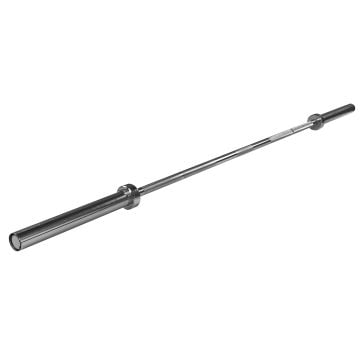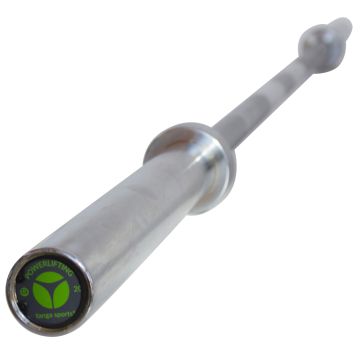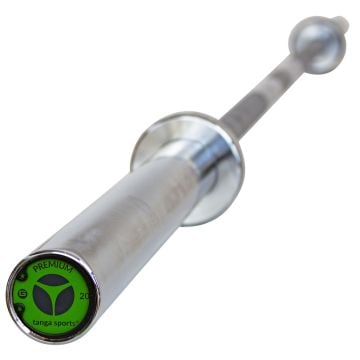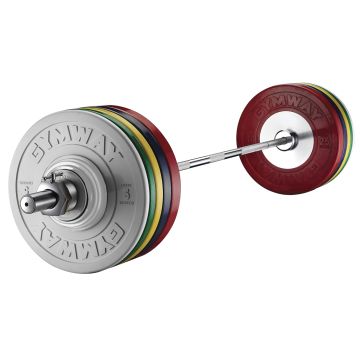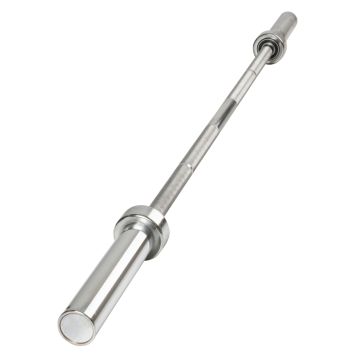
Barbells
Resilient & durable barbells in different weights
Training with a barbell
Hardly any other training device or device in the fitness and sports sector has such a variety of exercises as the barbell. With a barbell, both beginners and beginners as well as advanced users can carry out effective training. The barbell or barbell training is very effective, especially in the area of strength endurance. In comparison to a dumbbell, the barbell has the advantage that the dumbbell can be loaded with more weight and can be varied widely between weights. As a result, more weight can be lifted in barbell training because fewer stabilizing muscles are involved. This is particularly interesting in muscle building, since barbell training involves less repetition but more weight. In the endurance range, on the other hand, you work with many repetitions and little weight. With a barbell bar, you can do an effective training for the entire body in the strength endurance area as well as to build muscle or to train whole muscle groups and muscles on the body. When training with a barbell, the entire body (muscle groups and specific muscles) is simply stressed or addressed (legs, arms, etc.). Popular exercises or basic exercises with a barbell are e.g. Lunge, barbell in the neck, pulling the front, squats (exercise for the legs and arms) or biceps curls (exercise for the arms). The only disadvantage of barbells is that when training with the barbell bar or during the basic exercises, many beginners overestimate themselves and place too much weight on the barbell bar. When training with a barbell, it is important that you always lift out of the muscle group mentioned. The back and shoulders do not work with it. For a correct execution and posture when training with the barbell, it is very helpful if you do the training in front of a mirror. You will also find suitable weight benches with us. You need a weight bench e.g. for the bench press exercise.
Form of a barbell: curl bar (curl) and straight bar
A barbell can either have a classic straight shape or a serrated shape (SZ bar or curl bar). The special shape of a curl bar gives a lot of support and enables effective training of the biceps or upper body. Because with a classic straight bar, the wrists are in an unnatural position during bicep training, which means a strong rotation of the hand outwards. The curl bar relieves the wrists or hands, gives the wrists or hands more mobility and enables two handle variants for an even more intensive response to the biceps area. For exercises such as bench presses, squats or deadlifts, barbells are more suitable.
Diameter of a barbell
In comparison to a dumbbell, barbells with a diameter of 30 mm and 50 mm are also sold. The barbell with a diameter of 30 mm is the standard model and the barbell with a diameter of 50 mm is the Olympic version. When buying a barbell, you should choose the diameter that corresponds to the diameter of the weight plates of your dumbbells. With a diameter of 30 mm, more weight or more weight plates can also be accommodated. Because then you can use the same weight plates for both the barbell and the barbell. You will also find complete barbell sets with different weights and lengths of the bars.
Length of a barbell
In addition to the diameter, the length of the barbell is crucial for good training. Even if short barbells are easier and more space-saving to store, when buying a barbell bar you should always follow your exercises when working out with a barbell bar. If you do not plan to do exercises that require a very wide grip (such as deadlifts), a length of 130 cm is perfectly sufficient. Exercises such as shoulder presses or standing rowing are easily possible with this barbell length. However, you should note that the more weight there is, the more difficult it is to balance such a barbell bar. If you already know that you want to carry out a workout or dumbbell training with more than 50 kg, then you should choose a length of 160 m. Such a length of the barbell bar is much more comfortable if you do exercises such as Want to do bench presses or deadlifts in training. If you want to make your training really professional and train with a lot of weight, you should use the Olympic barbell bars with a length of 220 cm. The maximum load of these bars is up to 500 kg. Regarding the grip width:
- Shoulder-wide grip and a hand's width: For most people this is the "normal" grip width and you can train the chest, the triceps and the front shoulder muscles well with this width. Most exercisers have the most strength with this width of the grip.
- Wide grip: With a wide grip, the muscles in the chest are stressed more and the triceps are relieved. Most of the time, in the bench press exercise with a wide grip to train or build up a massive chest muscles. The larger grip width also means a shorter lifting path, which means that many athletes can lift more weight. However, the actual performance does not necessarily increase.
- Tight grip: If you grip the barbell closer than the shoulder width, the load on the triceps increases significantly. The chest is relieved. The lifting distance increases, which corresponds to a higher performance with the same weight.
Material of barbells
As soon as you want to lift more than 30 kg, you should make sure that the barbell is made of solid cast iron or steel. Because the material steel or cast iron is extremely resilient, stable and durable. These properties are also necessary, because very high forces sometimes act on the barbell bar due to the heavy training. Barbell bars made of rubber or plastic are available for training with lower weight or for beginners in strength training. These materials have the advantage that they can be placed on the floor with little noise. The barbells made of this material not only avoid noise, but also protect the floor in the gym, in the exercise room at home or in the sports hall in the club.
What types of closures are there?
There are numerous closures for barbell bars. One can differentiate between the clamp closures and screw closures. To use screw caps you need a barbell bar with thread or thread profile on the weight holder. The star closures are available as screw caps. The star closures are characterized by a particularly high level of security with which the rod can be held. The thread prevents the weight from slipping sideways. For this reason, this locking system is particularly suitable for training beginners, but also for training with heavy weights. Locking systems for smooth barbell bars without thread are clamp locks. Compared to the star locks or screw locks, the clamp locks have the advantage that they are easier and faster when changing weights. The collar closures are available for the clamp closures. These have a good holding force and the weights can be changed quickly.




